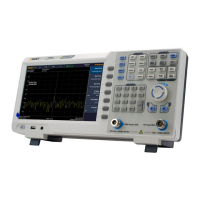Searches the peak with the minimum amplitude on the trace and
identifies it with a marker.
5.13.6 [Mkr→CF]
Used to move the peak point to the center frequency point.
5.13.7 [Cont Max On Off]
Set the peak search form, off by default. On mode will
automatically search for the peak.
5.14 【Marker】
The marker appears as a rhombic sign (shown below) for
identifying the point on the trace. We can easily readout the
parameters of the marked point on the trace, such as the amplitude,
frequency and sweep time.
Key points:
⚫ The analyzer allows for up to three groups of markers to be
displayed at one time, but only one pair or one single marker is
active every time.
⚫ You can use the numeric keys, knob or direction keys to enter
the desired frequency or time when any marker type menu is
active, so as to view the readouts of different points on the trace.
5.14.1 [Marker 1 2 3 4 5]
Selects one marker, the default is Marker1. And place the
frequency scale at the center of the trace. If the frequency
difference is activated, this softkey changes to the menu under the
[Difference] function.
If there is already a marker, this command will not produce any
operation. If there are already two markers (e.g. in [Difference]
mode), [Marker] changes the active frequency scale to a new
single frequency scale. Amplitude and frequency information can
be obtained from the frequency scale (time information when the

